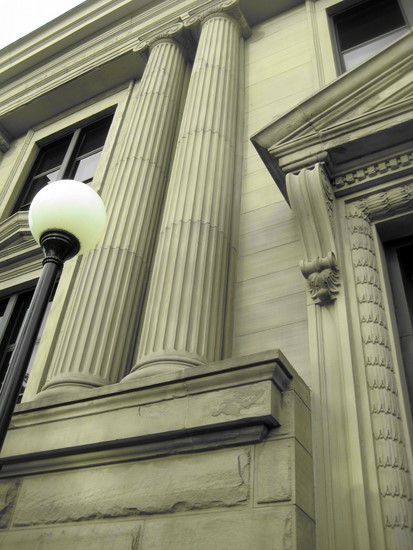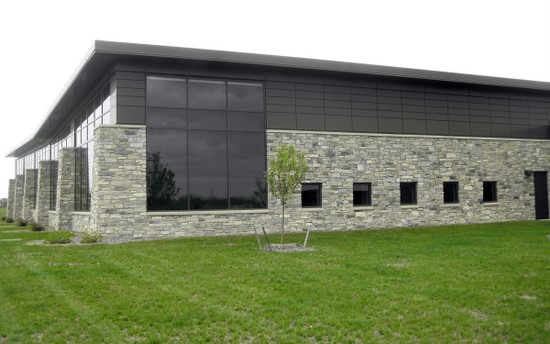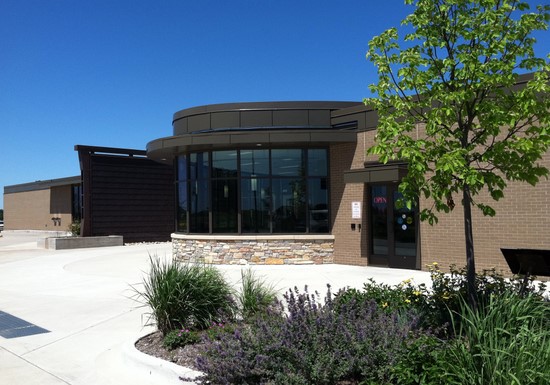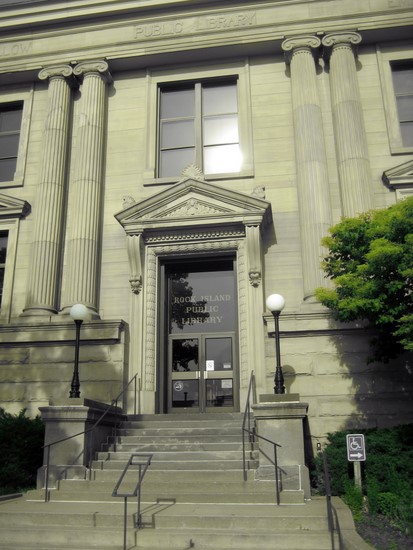 More than a century separates the opening dates of the most recent and the oldest public-library buildings in the Quad Cities. The differences between these buildings reflect our changing relationship to the environment, and their architecture reflects the evolution of the library from a symbol of culture to a community center.
More than a century separates the opening dates of the most recent and the oldest public-library buildings in the Quad Cities. The differences between these buildings reflect our changing relationship to the environment, and their architecture reflects the evolution of the library from a symbol of culture to a community center.
Davenport's Eastern Avenue branch library (at 6000 Eastern Avenue) opened a year ago on July 10. The horizontal shape of the building and curved entrance relate to its surrounding environment, an open, grassy area of gentle rolling hills. The library has been designated by the U.S. Green Building Council as a Leadership in Energy & Environmental Design (LEED) building. Its environmental features include a geothermal-heating and -cooling system, stormwater-management systems for the roof and parking areas, and energy-efficient lighting. Even the building materials were selected to ensure a healthy environment for the library staff and patrons.

At the library's entrance is a wall covered in sheets of bronze. The prominent position of the wall and its subtle patterning make it seem more like a minimalist sculpture than the means to drain water from the roof into the rain basin and bioswale. The bronze wall is set within a rain garden - planted with native plants and grasses, helping the water soak into the ground instead of running into the storm sewers. The ecologically conscious approach to the design of this building is remarkably different from the neoclassical design of libraries in the early 20th Century.

The Rock Island Main Library (at 401 19th Street in the Rock Island) opened on December 15, 1903. The building became the permanent home for a library collection that was established in 1855 and made public in 1872, making it the oldest public library in the state of Illinois. Funded primarily by Rock Island businessmen Frederick Weyerhaeuser and Frederick Denkmann, the building opened shortly before the Carnegie libraries in Davenport and Moline.
 Originally called Rock Island's Temple of Literature, the building's fluted Ionic columns, exterior of quarried stone, and classical-styled ornamentation are indeed derived from ancient Greek and Roman temples. The dozen names incised in the frieze near the roof - from the Greek poet Homer to the American writer Nathaniel Hawthorne - say, in effect, that there is an unbroken link between us and the founders of Western Civilization.
Originally called Rock Island's Temple of Literature, the building's fluted Ionic columns, exterior of quarried stone, and classical-styled ornamentation are indeed derived from ancient Greek and Roman temples. The dozen names incised in the frieze near the roof - from the Greek poet Homer to the American writer Nathaniel Hawthorne - say, in effect, that there is an unbroken link between us and the founders of Western Civilization.
One enters the main section of the building by ascending a flight of stone steps and passing through an imposing foyer. We literally rise higher when we come into this archive of knowledge. Though one is now greeted by collections of digital information - DVDs, CDs, and audiobooks - the interior architecture is formal, creating a very different atmosphere from the more welcoming and comfortable space of the newer libraries.
The Rock Island Main Library has had public meeting rooms and a children's collection of books - even an art gallery - from its inception. Yet this is a far cry from the community centers that libraries have evolved into. More than just lenders of books, libraries now provide Internet access and community rooms for a great range of not-for-profit organizations - from the Girl Scouts to senior groups, from choirs to quilters. When you are next looking for an a pleasant coffee shop, consider going to the library.
But are buildings art?
Frank Lloyd Wright, perhaps America's most renowned architect, certainly thought so when he stated, "The mother art is architecture."
Contemporary architect Richard Meier expanded on this by saying: "Architecture is the greatest of the arts, and it encompasses thinking that other arts don't even deal with. Like [the] relationship of the work to the individual human being - the person who uses it, the person who experiences it, the person who sees it, and how that person perceives that space."
Bruce Walters is a professor of art at Western Illinois University.
This is part of an occasional series on the history of public art in the Quad Cities. If there's a piece of public art that you'd like to learn more about, e-mail the location and a brief description to BD-Walters@wiu.edu.